In-Depth Review of Spectracide Carpenter Ant Killer
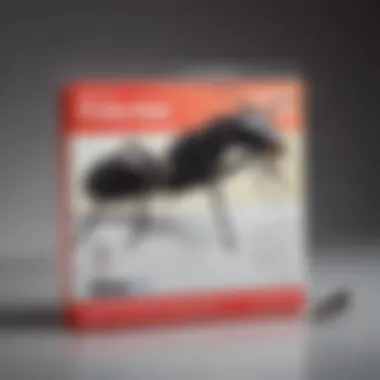
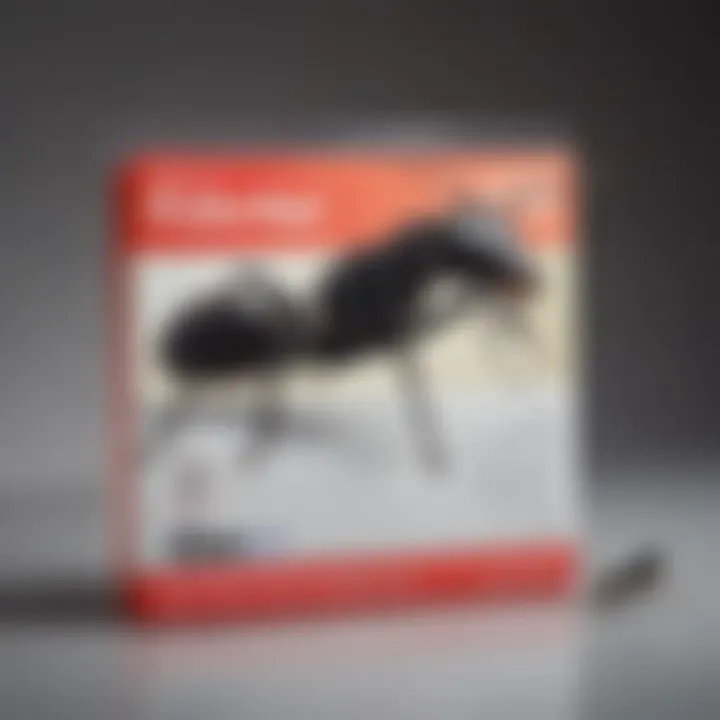
Intro
Effective pest management is crucial for maintaining healthy living spaces. Infestations not only cause stress but can also result in significant structural damage. Among the most notorious of these pests are carpenter ants. This article delves into the specifics of Spectracide Carpenter Ant Killer, a product designed to tackle these troublesome insects. It provides a detailed analysis of its formulation, efficacy, and safe application measures. Alongside this, the article explores the biology and behavior of carpenter ants, essential preventative steps, eco-friendly alternatives, and important safety considerations.
Understanding Pests
Definition of Pests
Pests are organisms that cause harm or nuisance to humans, animals, or plants. Carpenter ants fall into this category due to their wood-destroying tendencies. Their nesting behavior often leads them to infest homes, seeking out moist or decaying wood. Understanding the nature of these pests is vital in devising effective control strategies.
Importance of Pest Identification
Correctly identifying pests is a cornerstone of efficient pest management. It allows homeowners to understand the behavior and lifecycle of the pest in question. Failure to correctly identify a carpenter ant infestation can lead to inappropriate treatment methods, wasting time and resources.
Proper identification is crucial. Misidentified pests can result in ineffective treatment plans and prolonged infestations.
Prevention Techniques
Home and Garden Preventative Measures
To manage carpenter ant populations effectively, proactive prevention methods are essential. Homeowners should consider reducing moisture levels around their properties. Regularly checking for leaks and ensuring proper drainage can significantly deter these pests. Additionally, sealing cracks and openings in the foundation will help block entry points.
In gardens, removing decaying wood and debris is advisable. These materials serve as nesting sites, inviting ants to settle close to homes. Furthermore, maintaining a distance between mulch and the home's foundation can also help reduce the likelihood of infestations.
Seasonal Prevention Tips
Carpenter ants are often more active during the warmer months. Implementing seasonal checks is beneficial.
- In spring, inspect your home and garden for signs of wood damage or tunnels.
- Summer is the time for proactive outdoor maintenance; ensure wood stored outdoors is dry and elevated.
- Fall encourages preventive sealing of cracks and checking for any water accumulation around your home.
- Winter requires vigilance as ants may seek warmth indoors.
Eco-Friendly Pest Control Solutions
Overview of Sustainable Practices
With growing concerns over the impact of chemical treatments, many homeowners seek eco-friendly pest control methods. Integrated Pest Management, or IPM, combines various strategies, such as biological control, habitat manipulation, and the use of resistant varieties to minimize pest populations while reducing dependence on chemical pesticides. Spectracide Carpenter Ant Killer can be used in conjunction with such strategies to enhance efficacy without compromising safety.
Natural Remedies and Their Effectiveness
Natural remedies have gained traction over the years as viable alternatives to chemical treatments. Some popular methods include:
- Diatomaceous Earth: This powdery substance can be sprinkled around areas where ants are active. It dehydrates and eventually kills the insects.
- Boric Acid: This natural pesticide can be mixed with sugar water to lure ants, providing a slow-acting poison that can help reduce populations over time.
- Essential Oils: Some oils, like peppermint and clove, repel ants and can be used as a deterrent when mixed with water in a spray bottle.
While these methods are generally safer for the environment, homeowners should remain vigilant about their effectiveness and may need to combine them with other solutions like Spectracide for complete control.
Understanding Carpenter Ants
Understanding carpenter ants is fundamental to the effective management of these pests. Carpenter ants are not just ordinary insects; they can cause significant structural damage, leading to expensive repairs. This makes the knowledge of their biology, behavior, and signs of infestation crucial for homeowners. By comprehending these aspects, one can not only identify potential problems but also take proactive measures to prevent infestations.
Biology and Behavior


Carpenter ants belong to the family Formicidae and are characterized by their large size, typically measuring between 1/4 inch to 1 inch in length. They can be black, red, or a combination of colors. These ants do not consume wood as termites do. Instead, they excavate it to create nests, primarily in moist or decayed wood, making older homes particularly vulnerable. Their colonies can grow quite large, sometimes exceeding several thousand individuals.
The workers are the most visible members of the colony, foraging for food and maintaining the nest. Carpenter ants are nocturnal and prefer to be active in the dark, making their presence less obvious during the day. They are omnivorous, consuming a variety of food sources, including sweets, proteins, and fats. It’s important to note that their behavior is heavily influenced by environmental conditions, which affects their nesting sites and foraging patterns.
Signs of Infestation
Identifying the signs of a carpenter ant infestation is essential for timely intervention. Common indicators include:
- Wood Shavings: Unlike termites, carpenter ants leave behind fine wood shavings known as frass. This can often be found near the entry points of their nest.
- Visible Nests: Carpenter ant nests may be visible, particularly if they create a satellite nest inside a wall or hollow space.
- Noise: If you listen closely, you may hear a faint scratching sound coming from inside walls or wood structures as ants work on their nests.
- Foraging Trails: Look for trails of ants, especially at night, as they move in search of food. These trails often lead back to their nests.
Recognizing these signs can help take immediate steps to mitigate damage and manage the infestation.
"An early detection is key to effective pest management. Understanding the biology and behavior of carpenter ants enables homeowners to act quickly before the problem escalates."
In summary, having a well-rounded knowledge about carpenter ants sets the stage for effective treatment strategies. This foundational understanding of their biology and signs will lead into a more profound exploration of how products like Spectracide Carpenter Ant Killer can effectively be utilized.
Overview of Spectracide Carpenter Ant Killer
The Overview of Spectracide Carpenter Ant Killer is a vital segment in understanding how this product aids in controlling carpenter ant populations effectively. This overview provides insights into the formulation and application techniques that define its utility. Knowledge about these aspects ensures users can utilize the product efficiently, maximizing its efficacy against infestations.
Product Composition
The composition of Spectracide Carpenter Ant Killer plays a crucial role in its effectiveness. The active ingredients are specifically designed to target carpenter ants, a species known for their destructive tendencies. The primary active ingredient in this formulation is lambda-cyhalothrin, a synthetic pyrethroid that disrupts the nervous system of pests. This ingredient is known for its fast-acting properties, which means once the ants come into contact with it or ingest it, the results can be observed rapidly.
Additionally, the product contains inert ingredients. These are necessary for stabilizing the formula and enhancing its application. The combination of these elements creates a solution that not only kills ants but also aids in repelling them from treated areas. Understanding the composition helps users appreciate the science behind its effectiveness and reinforces the importance of following usage instructions carefully to ensure safety and the best results.
Application Methods
Application methods are critical to achieving successful results with Spectracide Carpenter Ant Killer. Users may encounter the product in different forms such as sprays or baits, each suitable for various scenarios. For instance, the liquid spray version is ideal for direct targeting of visible ants and nests. Users should ensure thorough coverage where ants are active, such as along trails, near entry points, and around structural wood surfaces.
On the other hand, bait stations allow for a more passive approach. Baits attract ants, which then carry the poisoned bait back to their nest. This method is particularly effective as it targets the colony, not just individual ants.
Proper application timing is also important. Applying the product in the evening when ants are most active will increase contact rates and improve control. Always read and follow the specific instructions on the label to ensure personal safety, as well as the safety of pets and the environment. This awareness will help in achieving long-term success in managing carpenter ant populations.
Efficacy of Spectracide Carpenter Ant Killer
Understanding the efficacy of Spectracide Carpenter Ant Killer is fundamental to grasping its role in pest management. This section examines how effectively the product eliminates carpenter ants, which can cause significant damage to wooden structures. Knowing the efficacy helps homeowners make informed decisions when faced with pest issues. It is crucial to look at how this ant killer works, and what users have experienced after application.
How It Works
Spectracide Carpenter Ant Killer employs a dual-action formula which is designed for swift and thorough pest control. The active ingredients in the formulation act quickly upon contact, targeting the nervous system of carpenter ants. This leads to rapid incapacitation and eventual death of the ants, effectively halting their reproductive cycle.
The product is also effective when ingested by ants, as the ants carry the poison back to their nests, spreading it to other members of the colony. This behavior is essential in reducing overall ant populations in and around the home. The ease of application is another advantage. Homeowners can spray it in areas where they notice ant activity, allowing for a direct attack on colonies that are established.
"The effectiveness of a pest control product determines its value. Spectracide Carpenter Ant Killer provides results that many users have depended on for years."
Additionally, the durable residual effect ensures that the formula continues to work over time, even after the initial application, further preventing reinfestation of carpenter ants in treated areas.
User Testimonials
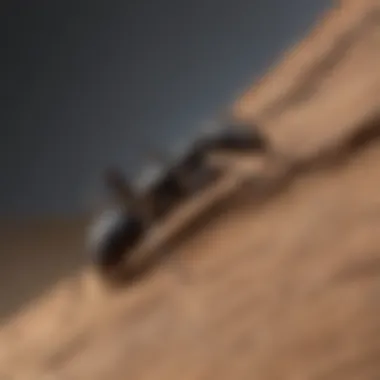

User experiences often reflect the true efficacy of a product. Many reviews indicate a high satisfaction rate with Spectracide Carpenter Ant Killer. Homeowners frequently report noticeable decreases in ant activity soon after application.
Some common feedback points include:
- Fast results: Many users observe a decline in carpenter ant sightings within a few days of using the product.
- Effective coverage: The spray nozzle can easily reach tight spaces where ants are likely to hide, such as inside walls and near wooden structures.
- Long-lasting solution: Users appreciate the residual effects, meaning they don’t need to reapply as often compared to other products.
However, some negative feedback also exists, with a few users noting that the product might not work as effectively if not applied correctly or in proper dosages. Following application instructions closely appears to enhance the overall efficacy. Assessing user testimonials along with product claims provides a more comprehensive understanding of Spectracide Carpenter Ant Killer’s effectiveness.
Safety Considerations
Understanding safety considerations is paramount when dealing with any pest control product, including Spectracide Carpenter Ant Killer. The efficacy of such products is often accompanied by concerns regarding their safety for human health and environmental impact. Homeowners must be aware of handling protocols to minimize risks during application, as well as long-term storage methods that reduce the chance of accidents. This section emphasizes not just compliance with usage guidelines but also the underlying benefits of good practices in safety management.
Handling and Storage Guidelines
To maintain safety while using Spectracide Carpenter Ant Killer, follow these handling and storage guidelines:
- Read the Label: Always begin your process by reading the manufacturer's instructions. This is vital for understanding the dos and don’ts of the product.
- Protective Gear: Wear gloves, masks, and goggles during application to shield yourself from chemical exposure. Skin contact and inhalation can lead to adverse health effects.
- Ventilation: Ensure adequate ventilation in the area where application occurs. Open windows or use fans to disperse any potential fumes.
- Secure Storage: Store the product in a cool, dry place away from children and pets. Lockable cabinets can provide an added layer of security.
- Avoid Mixing: Do not mix Spectracide Carpenter Ant Killer with other pesticides or chemicals unless specifically instructed. Such actions can produce harmful reactions.
- Dispose Responsibly: Follow local regulations for the disposal of pesticide containers. Do not throw them in regular trash. Instead, take them to a designated disposal facility.
These guidelines greatly increase safety and efficacy while using Spectracide Carpenter Ant Killer.
Impact on Humans and Pets
While Spectracide Carpenter Ant Killer is effective in controlling carpenter ant populations, its use necessitates an understanding of its potential impact on humans and pets. The following points elaborate on these considerations:
- Health Risks: Exposure to the active ingredients can cause health issues. Symptoms may include headaches, irritation of the eyes, skin, or respiratory tract. It’s important to be cautious, particularly among individuals with asthma or allergies.
- Pet Safety: Pets, particularly those with free access to treated areas, can be affected if they ingest the product. Keep pets away from areas that have been recently treated. Allow time for the product to dry before permitting them back into the treated spaces.
- Symptoms of Exposure: If accidentally exposed, symptoms vary from mild irritation to more serious conditions requiring medical attention. Watch for unusual behavior or signs of discomfort in both humans and pets.
"Safety and awareness are the first steps towards effective pest management."
- Regular Checks: After application, check treated areas regularly to ensure that it is safe for both humans and pets. This includes monitoring for any residue or signs of distress in household members.
By adhering to these safety considerations, homeowners can effectively mitigate risks associated with using Spectracide Carpenter Ant Killer.
Environmental Considerations
Understanding the environmental implications of pest control products is of great significance. This section discusses how the use of Spectracide Carpenter Ant Killer influences the local ecosystem and what considerations should be assessed before application. The goal is to provide a balanced view on effectiveness while acknowledging potential environmental impacts.
Ecological Effects
The ecological effects of using chemical pest control products can be extensive. When Spectracide Carpenter Ant Killer is applied, it can affect not just the target pests but also non-target organisms.
- Impact on Pollinators: Insects like bees and butterflies are crucial for pollination. Residual chemicals might drift to flower areas, harming these beneficial insects.
- Soil Health: Products that leach into the soil can disrupt the microbial balance. Healthy soil contains a variety of microorganisms that are vital for nutrient cycling and plant health.
- Aquatic Communities: Water runoff can carry chemicals into nearby streams or ponds. This can affect aquatic life, especially species that are sensitive to chemical pollutants.
- Desired Fauna: Natural predators such as birds may also be affected if they consume poisoned insects. This disruption can create an imbalance in the local ecosystem.
It's essential to consider these variables when planning an application of Spectracide. A more informed decision may lead to choosing safer methodologies or timing applications to minimize unintended exposure.
Sustainable Alternatives
As homeowners search for solutions to carpenter ant problems, exploring sustainable alternatives becomes necessary. Various methods offer efficacy while reducing environmental risks. Here are some options:
- Diatomaceous Earth: This naturally occurring substance can be sprinkled around entry points. It is safe for humans and pets but lethal to many insects, including carpenter ants.
- Boric Acid: This is a naturally occurring mineral that can effectively kill carpenter ants. It works as a slow-acting poison that ants bring back to their colony.
- Essential Oils: Some essential oils, such as peppermint and tea tree oil, can deter ants due to their strong scents. Mixing these oils with water and spraying can be effective for localized control.
- Prevention Tips: Keeping a clean environment, sealing cracks, and removing food sources can play a significant role in minimizing carpenter ant attractions to homes.
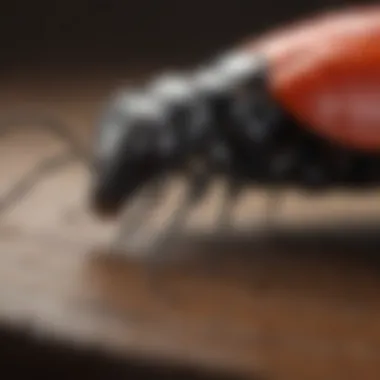
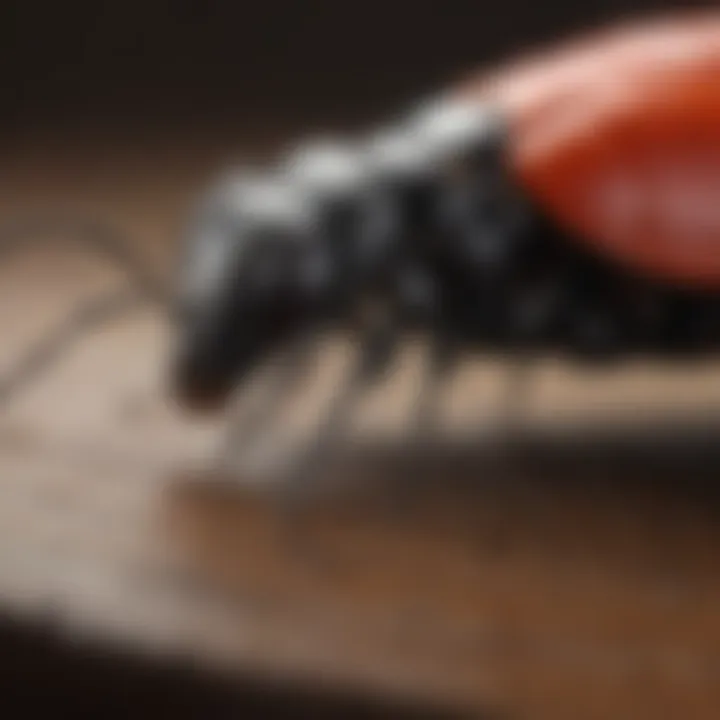
Adopting these methods not only addresses the immediate pest issue but also supports a more holistic, environmentally respectful approach to pest management.
Integrated Pest Management Strategies
Integrated Pest Management (IPM) is a holistic approach to pest control that emphasizes the use of a variety of strategies for managing carpenter ant populations. This method stands out because it combines multiple management practices to minimize pest damage while reducing reliance on chemical pesticides. Homeowners who understand IPM can protect their properties effectively, reduce costs, and enhance living conditions.
The core principles of Integrated Pest Management include monitoring, prevention, and control measures. IPM practices encourage a thorough understanding of pest behavior and environmental factors contributing to infestations. Therefore, adopting IPM strategies can result in long-term benefits, often leading to healthier homes and environments.
Preventive Measures
Preventive measures are key to achieving success in managing carpenter ants. Homeowners should focus on inspection and maintenance of their homes to deter these pests before they become an issue. Here are some effective preventative strategies:
- Sealing Entry Points: Inspect the home for cracks, gaps, or holes where carpenter ants might enter. Use caulk or expanding foam to seal these openings.
- Eliminating Food Sources: Keep food stored in airtight containers. Regularly clean up crumbs and spills to avoid attracting ants.
- Moisture Control: Carpenter ants are often drawn to moist environments. Ensure proper drainage around your home and fix any leaks promptly.
- Landscaping Practices: Trim tree branches and bushes to create distance between plants and the house. This can inhibit ants from finding pathways to your home.
These simple actions can significantly minimize the risk of infestation and should be regular practice for all homeowners.
Combining Solutions
Combining various pest management solutions provides a synergistic effect for controlling carpenter ants. Using both chemical products, such as Spectracide Carpenter Ant Killer, and non-chemical strategies can increase effectiveness. Key aspects to consider include:
- Baiting Systems: Using bait stations along with contact insecticides can help control populations. Baits attract ants, which carry the poison back to their colony. It ensures a more comprehensive eradication.
- Natural Predators: Introducing beneficial insects, like certain types of nematodes, can assist in controlling the ant population naturally.
- Regular Monitoring and Inspection: Routine checks can help detect early signs of carpenter ants. These checks enable quick responses using a combination of methods to tackle the problem.
The integration of varied strategies leverages strengths from each, providing a more effective and sustainable approach to pest control.
Regulatory Aspects
Understanding the regulatory aspects surrounding pest control products like Spectracide Carpenter Ant Killer is crucial for both consumers and manufacturers. Regulations ensure that products are safe for use and do not pose unmanageable risks to human health and the environment. Awareness of these regulations enables homeowners to make informed decisions about pest management options. Additionally, compliance with these guidelines is obligatory for manufacturers to secure their products' marketability.
Federal Regulations
Federal regulations govern the registration, labeling, and safe usage of pesticide products in the United States. The primary body overseeing this is the Environmental Protection Agency (EPA). The EPA establishes guidelines that aim to ensure pesticides do not harm the environment or human health. Products must demonstrate efficacy against pests, meet safety standards, and provide clear instructions for application and handling.
- Registration Process: New pesticide formulations, including Spectracide Carpenter Ant Killer, must go through rigorous testing before they can be registered. This involves data on toxicology, environmental impact, and efficacy.
- Label Requirements: Each registered product is required to have a label that details the active ingredients, directions for use, safety precautions, and environmental hazards. Consumers should always read this label to ensure proper use.
- Compliance Monitoring: The EPA conducts periodic reviews of registered products to ensure ongoing compliance with federal regulations. This ensures products on the market continue to meet safety and efficacy standards.
"Understanding federal regulations aids consumers in making informed choices about pest control solutions while ensuring safety."
State Licenses and Regulations
In addition to federal oversight, state regulations further govern the use of pesticide products. Each state has its own pesticide regulatory agency, often aligned with the EPA's guidelines but can set stricter regulations based on local needs.
- State Registration: Some states require additional registration for products being sold within their borders. This may include tailored labeling to address specific regional pest concerns.
- Licensing for Applicators: Many states require that pest control operators and contractors obtain licenses to apply pesticides. Homeowners should ensure that any professional they hire complies with these regulations.
- Public Education: States also provide educational resources to inform residents about safe pest control practices. These resources may include workshops, pamphlets, and online guidance to promote responsible pesticide use.
Navigating through both federal and state regulations can seem daunting. However, it is a necessary step to ensure that the use of Spectracide Carpenter Ant Killer is effective, safe, and legally compliant.
Closure
In this article, we have explored the various aspects of Spectracide Carpenter Ant Killer and its relevance in pest management. Understanding how to effectively combat carpenter ant infestations can greatly benefit homeowners striving for a pest-free environment. The effectiveness of a product like Spectracide cannot be overstated, as it provides a reliable solution within an integrated pest management strategy.
Final Thoughts on Effectiveness
The efficacy of Spectracide Carpenter Ant Killer lies in its ability to not only eliminate existing infestations but also provide a systemic solution that affects the entire colony. It works by interfering with the normal functioning of the ant's biological systems, leading to reduced populations both inside and outside the home. Homeowners have reported significant success when using this product as directed. However, it's essential to emphasize the importance of following application instructions to achieve the desired results. Reviewers on various platforms frequently highlight the quick action of this insecticide, which allows for immediate results, a crucial factor for those wanting to maintain a pest-free home.
Future Trends in Pest Control
As we move forward, the landscape of pest control is changing. Emerging trends suggest a shift towards more sustainable and environmentally friendly methods. Homeowners are increasingly aware of the ecological impact of chemical solutions. Therefore, there is a growing demand for integrated approaches combining chemical and non-chemical strategies.
Innovative technologies such as baiting systems and pheromone traps are gaining traction. These systems minimize the use of harmful chemicals while effectively managing ant populations. Additionally, advancements in research are leading to the development of new formulations that are less hazardous to both humans and pets, reflecting a broader environmental consciousness in pest control. By staying informed about these trends, homeowners can make educated choices that balance effectiveness and safety in their pest management strategies.



